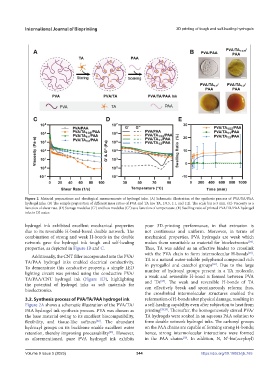Page 352 - IJB-9-5
P. 352
International Journal of Bioprinting 3D printing of tough and self-healing hydrogels
Figure 2. Material preparations and rheological measurements of hydrogel inks. (A) Schematic illustration of the synthesis process of PVA/TA/PAA
hydrogel inks. (B) The sample preparation of different mass ratios of PVA and TA (no TA, 1:0.5, 1:1, and 1:2). The scale bar is 5 mm. (C) Viscosity as a
function of shear rate. (D) Storage modulus (G′) and loss modulus (G″) as a function of temperature. (E) Swelling ratio of printed PVA/TA/PAA hydrogel
inks in DI water.
hydrogel ink exhibited excellent mechanical properties poor 3D-printing performance, in that extrusion is
due to its reversible H-bond-based double network. The not continuous and uniform. Moreover, in terms of
combination of strong and weak H-bonds in the double mechanical properties, PVA hydrogels are weak which
network gave the hydrogel ink tough and self-healing makes them unsuitable as material for bioelectronics .
[24]
properties, as depicted in Figure 1B and C. Thus, TA was added as an effective binder to crosslink
[25]
Additionally, the CNT filler incorporated into the PVA/ with the PVA chain to form intermolecular H-bonds .
TA/PAA hydrogel inks enabled electrical conductivity. TA is a natural water-soluble polyphenol compound rich
[26]
To demonstrate this conductive property, a simple LED in pyrogallol and catechol groups . Due to the large
lighting circuit was printed using the conductive PVA/ number of hydroxyl groups present in a TA molecule,
TA/PAA/CNT hydrogel ink (Figure 1D), highlighting a weak and reversible H-bond is formed between PVA
[27]
the potential of hydrogel inks as soft materials for and TA . The weak and reversible H-bonds of TA
bioelectronics. can effectively break and spontaneously reform; thus,
the crosslinked intermolecular structures enabled the
3.2. Synthesis process of PVA/TA/PAA hydrogel ink reformation of H-bonds after physical damage, resulting in
Figure 2A shows a schematic illustration of the PVA/TA/ a self-healing capability even after subjection to heat from
PAA hydrogel ink synthesis process. PVA was chosen as printing [28,29] . Thereafter, the homogeneously stirred PVA/
the base material owing to its excellent biocompatibility, TA hydrogels were soaked in an aqueous PAA solution to
flexibility, and tissue-like softness . The abundant form double network hydrogel inks. The carboxyl groups
[22]
hydroxyl groups on its backbone enable excellent water on the PAA chains are capable of forming strong H-bonds;
retention, thereby improving processability . However, hence, strong intermolecular interactions were formed
[23]
as aforementioned, pure PVA hydrogel ink exhibits in the PAA chains . In addition, N, N′-bis(acryloyl)
[30]
Volume 9 Issue 5 (2023) 344 https://doi.org/10.18063/ijb.765

